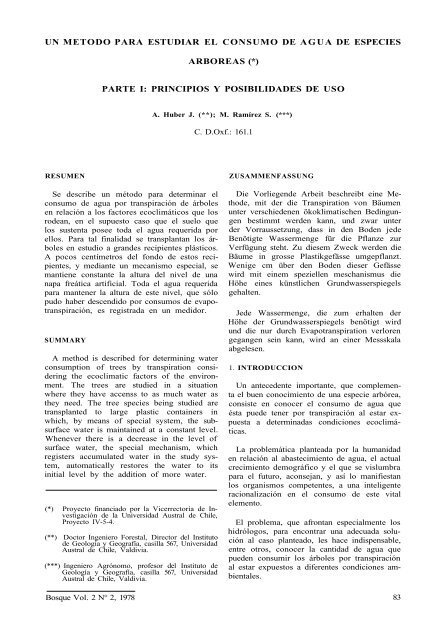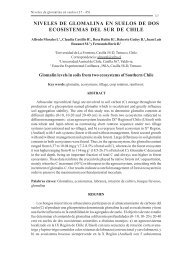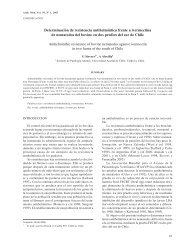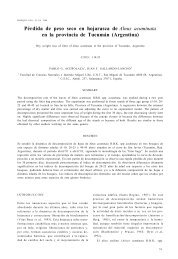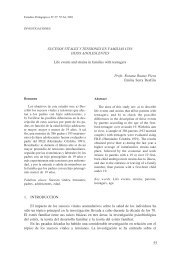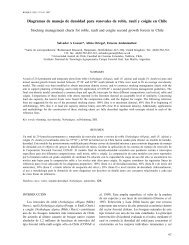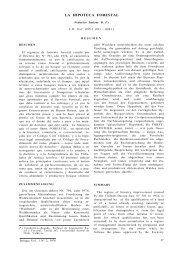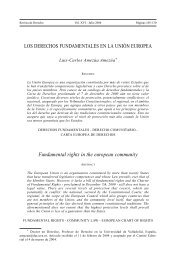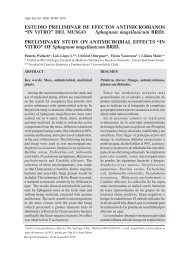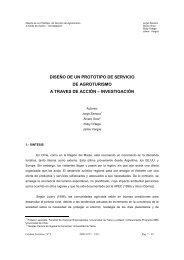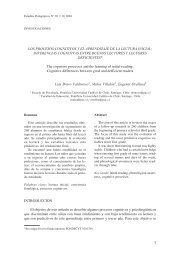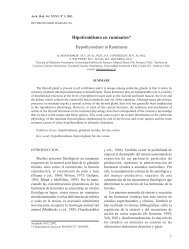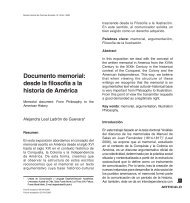un metodo para estudiar el consumo de agua de especies arboreas
un metodo para estudiar el consumo de agua de especies arboreas
un metodo para estudiar el consumo de agua de especies arboreas
You also want an ePaper? Increase the reach of your titles
YUMPU automatically turns print PDFs into web optimized ePapers that Google loves.
UN METODO PARA ESTUDIAR EL CONSUMO DE AGUA DE ESPECIES <br />
ARBOREAS (*) <br />
PARTE I: PRINCIPIOS Y POSIBILIDADES DE USO <br />
A. Huber J. (**); M. Ramírez S. (***)<br />
C. D.Oxf.: 161.1<br />
RESUMEN<br />
Se <strong>de</strong>scribe <strong>un</strong> método <strong>para</strong> <strong>de</strong>terminar <strong>el</strong><br />
<strong>consumo</strong> <strong>de</strong> <strong>agua</strong> por transpiración <strong>de</strong> árboles<br />
en r<strong>el</strong>ación a los factores ecoclimáticos que los<br />
ro<strong>de</strong>an, en <strong>el</strong> supuesto caso que <strong>el</strong> su<strong>el</strong>o que<br />
los sustenta posee toda <strong>el</strong> <strong>agua</strong> requerida por<br />
<strong>el</strong>los. Para tal finalidad se transplantan los árboles<br />
en estudio a gran<strong>de</strong>s recipientes plásticos.<br />
A pocos centímetros d<strong>el</strong> fondo <strong>de</strong> estos recipientes,<br />
y mediante <strong>un</strong> mecanismo especial, se<br />
mantiene constante la altura d<strong>el</strong> niv<strong>el</strong> <strong>de</strong> <strong>un</strong>a<br />
napa freática artificial. Toda <strong>el</strong> <strong>agua</strong> requerida<br />
<strong>para</strong> mantener la altura <strong>de</strong> este niv<strong>el</strong>, que sólo<br />
pudo haber <strong>de</strong>scendido por <strong>consumo</strong>s <strong>de</strong> evapotranspiración,<br />
es registrada en <strong>un</strong> medidor.<br />
SUMMARY<br />
A method is <strong>de</strong>scribed for <strong>de</strong>termining water<br />
consumption of trees by transpiration consi<strong>de</strong>ring<br />
the ecoclimatic factors of the environment.<br />
The trees are studied in a situation<br />
where they have accenss to as much water as<br />
they need. The tree species being studied are<br />
transplanted to large plastic containers in<br />
which, by means of special system, the subsurface<br />
water is maintained at a constant lev<strong>el</strong>.<br />
Whenever there is a <strong>de</strong>crease in the lev<strong>el</strong> of<br />
surface water, the special mechanism, which<br />
registers accumulated water in the study system,<br />
automatically restores the water to its<br />
initial lev<strong>el</strong> by the addition of more water.<br />
(*) Proyecto financiado por la Vicerrectoría <strong>de</strong> Investigación<br />
<strong>de</strong> la Universidad Austral <strong>de</strong> Chile,<br />
Proyecto IV-5-4.<br />
(**) Doctor Ingeniero Forestal, Director d<strong>el</strong> Instituto<br />
<strong>de</strong> Geología y Geografía, casilla 567, Universidad<br />
Austral <strong>de</strong> Chile, Valdivia.<br />
(***) Ingeniero Agrónomo, profesor d<strong>el</strong> Instituto <strong>de</strong><br />
Geología y Geografía, casilla 567, Universidad<br />
Austral <strong>de</strong> Chile, Valdivia.<br />
Bosque Vol. 2 N° 2, 1978<br />
ZUSAMMENFASSUNG<br />
Die Vorliegen<strong>de</strong> Arbeit beschreibt eine Metho<strong>de</strong>,<br />
mit <strong>de</strong>r die Transpiration von Bäumen<br />
<strong>un</strong>ter verschie<strong>de</strong>nen ökoklimatischen Beding<strong>un</strong>gen<br />
bestimmt wer<strong>de</strong>n kann, <strong>un</strong>d zwar <strong>un</strong>ter<br />
<strong>de</strong>r Vorraussetz<strong>un</strong>g, dass in <strong>de</strong>n Bo<strong>de</strong>n je<strong>de</strong><br />
Benötigte Wassermenge für die Pflanze zur<br />
Verfüg<strong>un</strong>g steht. Zu diesem Zweck wer<strong>de</strong>n die<br />
Bäume in grosse Plastikgefässe umgepflanzt.<br />
Wenige cm über <strong>de</strong>n Bo<strong>de</strong>n dieser Gefässe<br />
wird mit einem spezi<strong>el</strong>len meschanismus die<br />
Höhe eines künstlichen Gr<strong>un</strong>dwasserspieg<strong>el</strong>s<br />
gehalten.<br />
Je<strong>de</strong> Wassermenge, die zum erhalten <strong>de</strong>r<br />
Höhe <strong>de</strong>r Gr<strong>un</strong>dwasserspieg<strong>el</strong>s benötigt wird<br />
<strong>un</strong>d die nur durch Evapotranspiration verloren<br />
gegangen sein kann, wird an einer Messskala<br />
abg<strong>el</strong>esen.<br />
1. INTRODUCCION<br />
Un antece<strong>de</strong>nte importante, que complementa<br />
<strong>el</strong> buen conocimiento <strong>de</strong> <strong>un</strong>a especie arbórea,<br />
consiste en conocer <strong>el</strong> <strong>consumo</strong> <strong>de</strong> <strong>agua</strong> que<br />
ésta pue<strong>de</strong> tener por transpiración al estar expuesta<br />
a <strong>de</strong>terminadas condiciones ecoclimáticas.<br />
La problemática planteada por la humanidad<br />
en r<strong>el</strong>ación al abastecimiento <strong>de</strong> <strong>agua</strong>, <strong>el</strong> actual<br />
crecimiento <strong>de</strong>mográfico y <strong>el</strong> que se vislumbra<br />
<strong>para</strong> <strong>el</strong> futuro, aconsejan, y así lo manifiestan<br />
los organismos competentes, a <strong>un</strong>a int<strong>el</strong>igente<br />
racionalización en <strong>el</strong> <strong>consumo</strong> <strong>de</strong> este vital<br />
<strong>el</strong>emento.<br />
El problema, que afrontan especialmente los<br />
hidrólogos, <strong>para</strong> encontrar <strong>un</strong>a a<strong>de</strong>cuada solución<br />
al caso planteado, les hace indispensable,<br />
entre otros, conocer la cantidad <strong>de</strong> <strong>agua</strong> que<br />
pue<strong>de</strong>n consumir los árboles por transpiración<br />
al estar expuestos a diferentes condiciones ambientales.<br />
83
A. Huber J. y M. Ramírez S.<br />
Hay muchos trabajos, que persiguen a través<br />
<strong>de</strong> diferentes caminos <strong>de</strong>terminar <strong>el</strong> <strong>consumo</strong><br />
<strong>de</strong> <strong>agua</strong> <strong>de</strong> las plantas (Polster, 1957; Bra<strong>un</strong>,<br />
1970; Bra<strong>un</strong>, 1973; Schmidt, 1973; Fritschen,<br />
1977; Baumgartner, 1965; Iltner, 1968.<br />
No es la intención, en este estudio, analizar<br />
cada <strong>un</strong>o <strong>de</strong> los métodos empleados <strong>para</strong> alcanzar<br />
tal finalidad, pero sí po<strong>de</strong>mos <strong>de</strong>cir que<br />
muchos <strong>de</strong> <strong>el</strong>los tienen <strong>el</strong> inconveniente, que<br />
<strong>de</strong>terminan <strong>el</strong> <strong>consumo</strong> <strong>de</strong> <strong>agua</strong> en forma indirecta,<br />
y por tal motivo no se obtienen valores<br />
absolutos d<strong>el</strong> <strong>agua</strong> consumida por transpiración.<br />
Es así como Brecht<strong>el</strong> (1972) <strong>de</strong>termina la<br />
transpiración usando <strong>para</strong> <strong>el</strong>lo <strong>el</strong> balance hídrico<br />
E = N-A; E = evaporación, N = precipitación,<br />
A = escurrimiento. Baumgartner (1965)<br />
hizo lo suyo usando <strong>para</strong> <strong>el</strong>lo <strong>el</strong> balance energético.<br />
Itter (1968) calcula la v<strong>el</strong>ocidad <strong>de</strong> ascenso<br />
d<strong>el</strong> <strong>agua</strong> xilemática y <strong>de</strong>termina así la supuesta<br />
transpiración.<br />
Fischer (1975) <strong>de</strong>termina en forma directa<br />
los <strong>consumo</strong>s <strong>de</strong> <strong>agua</strong> por árboles, pero ocupan<br />
<strong>para</strong> <strong>el</strong>lo sofisticadas y costosas instalaciones<br />
lisimétricas.<br />
Bra<strong>un</strong> (1970), (1973) y Schmidt (1973) trasplantan<br />
árboles a recipientes con arena llenados<br />
hasta media altura con solución nutriente.<br />
La transpiración en este caso se cuantifica según<br />
<strong>el</strong> volumen <strong>de</strong> solución consumida.<br />
Otros autores, utilizan <strong>para</strong> <strong>el</strong> estudio, plantas<br />
muy jóvenes o incluso solo parte <strong>de</strong> <strong>el</strong>las,<br />
lo que trae como consecuencia que los ensayos<br />
se hacen en condiciones muy distintas a las<br />
que existen en la naturaleza.<br />
El presente estudio tiene por finalidad diseñar<br />
y poner en práctica <strong>un</strong> método r<strong>el</strong>ativamente<br />
sencillo <strong>para</strong> <strong>de</strong>terminar <strong>el</strong> <strong>consumo</strong> <strong>de</strong><br />
<strong>agua</strong> por transpiración <strong>de</strong> árboles en valores<br />
absolutos, cuando <strong>el</strong> árbol dispone <strong>de</strong> toda <strong>el</strong><br />
<strong>agua</strong> requerida en <strong>el</strong> su<strong>el</strong>o. Posteriormente, y<br />
en trabajos futuros, se <strong>de</strong>terminará la influencia<br />
que tienen los factores ecoclimáticos sobre<br />
<strong>el</strong> monto <strong>de</strong> la transpiración.<br />
2. PRINCIPIO DEL METODO<br />
2.1. Diseño d<strong>el</strong> equipo sugerido (Fig. 1).<br />
En <strong>un</strong> recipiente <strong>de</strong> aproximadamente 50 cm<br />
<strong>de</strong> diámetro y 90 cm <strong>de</strong> altura (a), se <strong>de</strong>positó<br />
<strong>un</strong>a capa <strong>de</strong> ripio d<strong>el</strong>gado <strong>de</strong> 15 cm <strong>de</strong> espesor<br />
(x) que tiene la f<strong>un</strong>ción <strong>de</strong> <strong>un</strong> horizonte<br />
muy permeable. El recipiente a se llenó hasta<br />
84<br />
10 cm d<strong>el</strong> bor<strong>de</strong> con tierra, y <strong>el</strong> espacio restante<br />
con grava fina (y).<br />
Un conducto plástico <strong>de</strong> 12 mm <strong>de</strong> diámetro<br />
<strong>un</strong>e al recipiente principal (a) con otro mucho<br />
más pequeño (c). Este recipiente <strong>de</strong> aproximadamente<br />
250 cm 3 , y como se verá posteriormente,<br />
tiene por finalidad regular la altura d<strong>el</strong><br />
niv<strong>el</strong> <strong>de</strong> <strong>agua</strong> en <strong>el</strong> recipiente principal (a).<br />
Fig. 1.— Instalaciones sugeridas por <strong>el</strong> método<br />
propuesto <strong>para</strong> <strong>de</strong>terminar <strong>el</strong> <strong>consumo</strong><br />
<strong>de</strong> <strong>agua</strong> por transpiración <strong>de</strong> árboles.<br />
El recipiente c está perforado en su parte<br />
superior por dos tubos <strong>de</strong> vidrio <strong>de</strong> 5 mm <strong>de</strong><br />
diámetro (d y e). Estos tubos se introducen en<br />
<strong>el</strong> recipiente con <strong>un</strong>a diferencia <strong>de</strong> longitud <strong>de</strong><br />
2 cm. Ambos tubos <strong>de</strong> vidrio poseen <strong>un</strong>a llave<br />
<strong>de</strong> paso (h 1<br />
, h 2<br />
) y están <strong>un</strong>idos mediante mangueras<br />
a <strong>un</strong> recipiente calibrado f. Este recipiente,<br />
en su costado superior, tiene <strong>un</strong>a llave<br />
1 a través <strong>de</strong> la cual se llena con <strong>agua</strong>. Una<br />
vez lleno se cierra la llave 1 y se abren las<br />
llaves h 1<br />
y h 2<br />
. En este instante <strong>el</strong> <strong>agua</strong> d<strong>el</strong><br />
recipiente f pasa por <strong>el</strong> conducto d al recipiente<br />
c, <strong>de</strong>s<strong>de</strong> aquí y a través <strong>de</strong> g sigue al recipiente<br />
principal (a). El volumen <strong>de</strong> <strong>agua</strong>, que circula<br />
por <strong>el</strong> conducto d hacia <strong>el</strong> recipiente c<br />
es equivalente al volumen <strong>de</strong> aire que circula<br />
por <strong>el</strong> conducto e y llega al recipiente f.<br />
Como los recipientes a y c están <strong>un</strong>idos por<br />
<strong>un</strong> conducto g, la altura d<strong>el</strong> niv<strong>el</strong> <strong>de</strong> <strong>agua</strong> en<br />
<strong>el</strong> recipiente a es igual que en c por <strong>el</strong> principio<br />
<strong>de</strong> los vasos com<strong>un</strong>icantes. A su vez, la<br />
altura <strong>de</strong> <strong>agua</strong> en <strong>el</strong> recipiente c está <strong>de</strong>terminada<br />
por la posición d<strong>el</strong> extremo inferior d<strong>el</strong><br />
tubo <strong>de</strong> vidrio más corto e. Si ahora, por evaporación<br />
o transpiración, se gasta <strong>agua</strong>, entonces<br />
baja <strong>el</strong> niv<strong>el</strong> <strong>de</strong> <strong>agua</strong> en <strong>el</strong> recipiente<br />
a, y la altura d<strong>el</strong> niv<strong>el</strong> <strong>de</strong> <strong>agua</strong> en <strong>el</strong> recipiente<br />
c experimenta idéntico <strong>de</strong>scenso. Este<br />
Bosque Vol. 2 N° 2, 1978
Un método <strong>para</strong> <strong>estudiar</strong> <strong>el</strong> <strong>consumo</strong> <strong>de</strong> <strong>agua</strong> <strong>de</strong> <strong>especies</strong> arbóreas<br />
<strong>de</strong>scenso permite que se interrumpa <strong>el</strong> contacto<br />
entre la superficie d<strong>el</strong> <strong>agua</strong> d<strong>el</strong> recipiente c<br />
y la boca d<strong>el</strong> tubo e. En este instante se le<br />
da paso al aire que ascien<strong>de</strong> por <strong>el</strong> tubo e<br />
succionado por <strong>el</strong> vacío que hay en <strong>el</strong> recipiente<br />
f. Ahora comienza a <strong>de</strong>scen<strong>de</strong>r <strong>un</strong>a cantidad<br />
<strong>de</strong> <strong>agua</strong> por <strong>el</strong> conducto d, equivalente<br />
al volumen <strong>de</strong> aire que penetró al recipiente f.<br />
En <strong>el</strong> momento, en <strong>el</strong> cual <strong>el</strong> niv<strong>el</strong> <strong>de</strong> <strong>agua</strong> d<strong>el</strong><br />
recipiente c vu<strong>el</strong>ve a obstruir <strong>el</strong> paso <strong>de</strong> aire<br />
por <strong>el</strong> tubo <strong>de</strong> vidrio e se <strong>de</strong>tiene <strong>el</strong> flujo <strong>de</strong><br />
<strong>agua</strong> por <strong>el</strong> conducto d hacia <strong>el</strong> recipiente c.<br />
En estas condiciones se ha vu<strong>el</strong>to a recuperar<br />
la altura primitiva d<strong>el</strong> niv<strong>el</strong> <strong>de</strong> <strong>agua</strong> en los recipientes<br />
a y c y <strong>el</strong> <strong>agua</strong> que se ocupó <strong>para</strong><br />
tal finalidad se pue<strong>de</strong> <strong>de</strong>terminar por <strong>el</strong> <strong>de</strong>scenso<br />
<strong>de</strong> altura que experimentó <strong>el</strong> niv<strong>el</strong> <strong>de</strong><br />
<strong>agua</strong> en <strong>el</strong> recipiente calibrado f.<br />
2.2. F<strong>un</strong>cionamiento.<br />
A alg<strong>un</strong>os <strong>de</strong> los recipientes principales,<br />
como <strong>el</strong> que se muestra en la figura 1, a, se<br />
transplantan las <strong>especies</strong> arbóreas que se <strong>estudiar</strong>án<br />
<strong>para</strong> <strong>de</strong>terminar la cantidad <strong>de</strong> <strong>agua</strong> que<br />
consumen por transpiración.<br />
En las instalaciones, con recipientes principales<br />
que solo contienen su<strong>el</strong>o, se pue<strong>de</strong> <strong>de</strong>terminar<br />
la cantidad <strong>de</strong> <strong>agua</strong> ocupada por evaporación<br />
(Ev), y en los otros don<strong>de</strong> están las<br />
<strong>especies</strong> arbóreas, se pue<strong>de</strong> <strong>de</strong>terminar la cantidad<br />
<strong>de</strong> <strong>agua</strong> ocupada por transpiración y evaporación<br />
(evapotranspiración = EvTr). Con<br />
estos dos antece<strong>de</strong>ntes y por simple sustracción,<br />
se pue<strong>de</strong> <strong>de</strong>terminar la transpiración (Tr)<br />
<strong>de</strong> los árboles en estudio.<br />
EvTr — Ev = Tr (1)<br />
A pesar que <strong>el</strong> su<strong>el</strong>o colocado en todos los<br />
recipientes principales fue <strong>el</strong> mismo, se adviertieron<br />
ciertas diferencias entre las cantida<strong>de</strong>s<br />
<strong>de</strong> <strong>agua</strong> perdida por evaporación. Estas diferencias<br />
podrían traer errores significativo en<br />
<strong>el</strong> cálculo d<strong>el</strong> volumen <strong>de</strong> <strong>agua</strong>, perdido por<br />
evaporación con la fórmula 1, especialmente,<br />
durante los períodos en los cuales las <strong>especies</strong><br />
arbóreas sólo consumen cantida<strong>de</strong>s pequeñas<br />
<strong>de</strong> <strong>agua</strong> por transpiración. Estos errores se pudieron<br />
reducir a valores mínimos, cuando las<br />
superficies <strong>de</strong> los su<strong>el</strong>os —en los recipientes<br />
principales— se cubrieron con <strong>un</strong>a capa <strong>de</strong><br />
grava fina <strong>de</strong> aproximadamente 10 cm <strong>de</strong> espesor.<br />
Esta capa <strong>de</strong> grava cumple <strong>un</strong>a doble<br />
finalidad: permite que a través <strong>de</strong> <strong>el</strong>la circule<br />
todavía suficiente aire indispensable <strong>para</strong> <strong>un</strong>a<br />
a<strong>de</strong>cuada aireación d<strong>el</strong> su<strong>el</strong>o y disminuya fuertemente<br />
<strong>el</strong> ascenso d<strong>el</strong> <strong>agua</strong> capilar, <strong>de</strong>bido al<br />
Bosque Vol. 2 N° 2, 1978<br />
tamaño <strong>de</strong> sus poros. Esto último trae como<br />
consecuencia, que la cantidad <strong>de</strong> <strong>agua</strong> perdida<br />
por evaporación se haga mínima, y con <strong>el</strong>lo<br />
también se reduzcan al máximo las diferencias,<br />
en valores absolutos, entre las cantida<strong>de</strong>s <strong>de</strong><br />
<strong>agua</strong> perdida por evaporación <strong>de</strong> los su<strong>el</strong>os <strong>de</strong><br />
los distintos recipientes principales.<br />
2.3. Utilidad d<strong>el</strong> método.<br />
La posibilidad <strong>de</strong> uso y la bondad d<strong>el</strong> método<br />
propuesto se <strong>de</strong>mostrará en <strong>el</strong> ejemplo siguiente.<br />
A mediados <strong>de</strong> julio <strong>de</strong> 1976 se transplantó<br />
<strong>un</strong> coigüe Nothofagus dombeyi (Mirb.) Oerst.<br />
proveniente d<strong>el</strong> arboretum <strong>de</strong> la Facultad <strong>de</strong><br />
Ingeniería Forestal, ubicada en Isla Teja Norte,<br />
a <strong>un</strong>o <strong>de</strong> los recipientes principales propuestos<br />
por <strong>el</strong> método (Fig. 1, a). Este equipo se instaló<br />
en la Estación Meteorológica Teja ubicada<br />
en <strong>el</strong> campus <strong>de</strong> la Universidad Austral. El<br />
coigüe transplantado tenía <strong>un</strong>a altura <strong>de</strong> 2,15<br />
m y 20.550 hojas con <strong>un</strong>a superficie foliar (*)<br />
simple <strong>de</strong> aproximadamente 1,55 m 2 .<br />
A principios <strong>de</strong> septiembre, dos meses <strong>de</strong>spués<br />
d<strong>el</strong> transplante, se inició <strong>el</strong> período <strong>de</strong><br />
observaciones tendientes a <strong>de</strong>terminar la cantidad<br />
<strong>de</strong> <strong>agua</strong> que consumirá <strong>el</strong> árbol en estudio<br />
por transpiración durante su período vegetativo.<br />
Estos <strong>consumo</strong>s <strong>de</strong> <strong>agua</strong> se <strong>de</strong>terminaron<br />
semanalmente, al igual que las temperaturas<br />
y humeda<strong>de</strong>s medias d<strong>el</strong> aire <strong>para</strong> iguales<br />
períodos y que aparecen graficados en la Fig. 2.<br />
A partir d<strong>el</strong> 3 <strong>de</strong> septiembre y con intervalos<br />
<strong>de</strong> 8 semanas se contabilizaron todas las hojas<br />
d<strong>el</strong> árbol y se calculó la superficie foliar total.<br />
Estos datos permitieron <strong>de</strong>terminar la variación<br />
d<strong>el</strong> número <strong>de</strong> hojas, <strong>de</strong> la superficie foliar<br />
y d<strong>el</strong> <strong>consumo</strong> <strong>de</strong> <strong>agua</strong> por transpiración <strong>de</strong><br />
estos períodos <strong>de</strong> 8 semanas.<br />
Durante la primera semana <strong>de</strong> medición prácticamente<br />
no hubo <strong>consumo</strong> <strong>de</strong> <strong>agua</strong> por transpiración<br />
(Fig. 2). Pero <strong>el</strong>lo se podría <strong>de</strong>ber<br />
a que la temperatura promedia d<strong>el</strong> aire, <strong>para</strong><br />
esta semana, fue muy baja en com<strong>para</strong>ción a<br />
las siguientes.<br />
(°) Para medir la superficie foliar total d<strong>el</strong> árbol se<br />
contabilizaron todas las hojas d<strong>el</strong> árbol clasificándolos<br />
en muy chicas, chicas, medianas y gran<strong>de</strong>s.<br />
Posteriormente se escogieron 50 hojas representativas<br />
<strong>para</strong> cada <strong>un</strong>o <strong>de</strong> los grupos <strong>para</strong> <strong>de</strong>terminar<br />
la superficie foliar promedia <strong>de</strong> la hoja representativa<br />
<strong>para</strong> <strong>el</strong> grupo con ayuda d<strong>el</strong> Automatic<br />
Area Meter (Tokyo Hayashi Denko Co Ltd.)<br />
La superficie foliar <strong>de</strong> la hoja representativa <strong>de</strong><br />
cada grupo se multiplicó por <strong>el</strong> número <strong>de</strong> hojas<br />
d<strong>el</strong> grupo obteniéndose así la superficie foliar d<strong>el</strong><br />
grupo. La suma <strong>de</strong> la superficie foliar <strong>de</strong> los cuatro<br />
grupos dieron la superficie foliar total d<strong>el</strong><br />
árbol.<br />
85
A. Huber J. y M. Ramírez S.<br />
Fig. 2.— Consumo <strong>de</strong> <strong>agua</strong> semanal y por períodos <strong>de</strong> cuatro semanas por transpiración<br />
con las correspondientes temperaturas y humeda<strong>de</strong>s r<strong>el</strong>ativas d<strong>el</strong><br />
aire.<br />
También se pudo observar que los brotes dado se <strong>de</strong>bió principalmente a los trastornos<br />
d<strong>el</strong> coigüe comenzaron a <strong>de</strong>sarrollarse, pero en sufridos por <strong>el</strong> árbol en <strong>el</strong> trasplante.<br />
forma <strong>de</strong>masiado lenta. Este <strong>de</strong>sarrollo retar-<br />
CUADRO N° 1<br />
Variación d<strong>el</strong> número <strong>de</strong> hojas, superficie foliar y <strong>consumo</strong> <strong>de</strong> <strong>agua</strong> durante períodos <strong>de</strong> 8<br />
semanas d<strong>el</strong> árbol en estedio.<br />
Para obtener <strong>un</strong>a pronta recuperación d<strong>el</strong> árbol,<br />
en primera instancia, se abonó <strong>el</strong> su<strong>el</strong>o d<strong>el</strong><br />
86<br />
recipiente principal (28-X-76) y posteriormente<br />
se reemplazó <strong>el</strong> <strong>agua</strong> pura, que en forma con-<br />
Bosque Vol. 2 N° 2, 1978
Un método <strong>para</strong> <strong>estudiar</strong> <strong>el</strong> <strong>consumo</strong> <strong>de</strong> <strong>agua</strong> <strong>de</strong> <strong>especies</strong> arbóreas<br />
trolada se suministraba al recipiente principal, la sensibilidad d<strong>el</strong> método propuesto es lo supor<br />
<strong>un</strong>a solución Knop(l) diluida en <strong>un</strong>a r<strong>el</strong>a ficientemente exacto incluso <strong>para</strong> <strong>de</strong>terminar<br />
ción 1:10.<br />
los <strong>consumo</strong>s <strong>de</strong> <strong>agua</strong> por períodos cortos <strong>de</strong><br />
tiempo.<br />
A fines <strong>de</strong> noviembre estos procedimientos<br />
dieron los primeros resultados. Los brotes y 3. CONCLUSIONES<br />
las hojas recuperaron su crecimiento normal<br />
lo que trajo consigo <strong>un</strong> incremento significati El método propuesto en <strong>el</strong> presente estudio,<br />
es <strong>un</strong> método a<strong>de</strong>cuado <strong>para</strong> <strong>de</strong>terminar <strong>el</strong> con<br />
sumo <strong>de</strong> <strong>agua</strong> por transpiración <strong>de</strong> árboles<br />
cuando toda <strong>el</strong> <strong>agua</strong> requerida <strong>de</strong> la planta está<br />
disponible en <strong>el</strong> su<strong>el</strong>o. Su precisión es lo suficientemente<br />
aceptable <strong>para</strong> cuantificar los <strong>consumo</strong>s<br />
diarios <strong>de</strong> <strong>agua</strong> e incluso <strong>para</strong> <strong>de</strong>ter<br />
minar <strong>el</strong> curso diario <strong>de</strong> la transpiración.<br />
vo <strong>de</strong> la superficie foliar total d<strong>el</strong> árbol (Cuadro<br />
N° 1).<br />
Fig. 3.— Curso diario d<strong>el</strong> <strong>consumo</strong> <strong>de</strong> <strong>agua</strong><br />
(lts/hr) por transpiración <strong>de</strong> las <strong>especies</strong><br />
arbóreas en estudio (17-II a 18-<br />
II-1977).<br />
4. METAS FUTURAS<br />
Comprobada la factibilidad <strong>de</strong> uso d<strong>el</strong> método<br />
propuesto, se plantean <strong>para</strong> <strong>el</strong> futuro las siguientes<br />
tareas:<br />
a) Automatizar y simplificar al máximo <strong>el</strong> reabastecimiento<br />
<strong>de</strong> <strong>agua</strong> d<strong>el</strong> equipo sugerido<br />
en <strong>el</strong> método.<br />
b) Determinar <strong>el</strong> <strong>consumo</strong> <strong>de</strong> <strong>agua</strong> por transpiración<br />
<strong>de</strong> las principales <strong>especies</strong> forestales<br />
chilenas, corr<strong>el</strong>acionando estos valores<br />
con las condiciones ambientales: temperaturas,<br />
humedad, radiación solar y ventilación.<br />
c) Determinar en forma aproximada los períodos<br />
<strong>de</strong> inicio y término <strong>de</strong> los períodos vege<br />
En la Fig. 3 se pue<strong>de</strong> observar <strong>el</strong> curso dia tativos <strong>de</strong> las <strong>especies</strong> arbóreas en estudio.<br />
rio <strong>de</strong> la transpiración (lts/hr) <strong>de</strong> la especie d) Determinar r<strong>el</strong>aciones entre <strong>consumo</strong> <strong>de</strong><br />
arbórea en estudio; <strong>de</strong> <strong>el</strong>la se <strong>de</strong>spren<strong>de</strong> que <strong>agua</strong> y producción.<br />
REFERENCIAS<br />
BAUMGARTNER, A. 1965. The head, water and carbon dioxi<strong>de</strong> budget of plant<br />
cover. Methods and measurements. Arid Zone Research, Vol. XXV. pp. 495-512.<br />
UNESCO. Paris.<br />
BRAUN, H.J. 1970. Eine Metho<strong>de</strong> für die Untersuch<strong>un</strong>gen <strong>de</strong>s Wasserverbrauches<br />
<strong>de</strong>r Holzpflanzen. Forstwissenschaftliches Central-blatt 89, 189-194.<br />
BRAUN, H.J. 1973. Baum <strong>un</strong>d Umw<strong>el</strong>t. Allg. Forst-u. Jagdztg., 144, 60-62.<br />
BRAUN, H.J. 1974. Rhythmus <strong>un</strong>d Grösse von Wachstum, Wasserverbrauch <strong>un</strong>d<br />
Produktivität <strong>de</strong>s Wasserverbrauches bei Holzpflanzen. Allg. Forst-u. Jagdztg.,<br />
145, 81-86.<br />
FRITSCHEN, L. 1973. A 28 meter Douglas für in a Weighin Lysimeter. Forest<br />
Science Vol. 19, N° 4, pp. 256-261.<br />
ITTER, E. 1968. Der Tagesgang <strong>de</strong>r geschwindigkeit <strong>de</strong>s Transpirationstromes im<br />
Stamm einer 75-Jährige Fichte Ecol. Plant. Gauthier-Villars III. 177-183.<br />
POLSTER, H. 1957. Transpirationsintensität <strong>un</strong>d Wasserbedarf von Papp<strong>el</strong>klonen.<br />
Wiss. Abh.Dtsch.Akad. Landw. Wiss. Berlin. 27, 99-147.<br />
SCHMIDT, P. 1973. Zum Wasserverbrauch verschie<strong>de</strong>ner Papp<strong>el</strong>klone. Allg.Forst u.<br />
Jagdztg., 144, 63-64.<br />
(1) Solución Knop: 1g Ca (NO3) 2 ; 0,25 gMgrSO 4 • 7<br />
H2O; 0,25 gKH2PO4 0,25 gKNO3 y<br />
H2O;<br />
trazas <strong>de</strong> FeSO 4 : 7 H2O disu<strong>el</strong>to<br />
en 1 litro <strong>de</strong> <strong>agua</strong>.<br />
Bosque Vol. 2 N° 2, 1978 87


